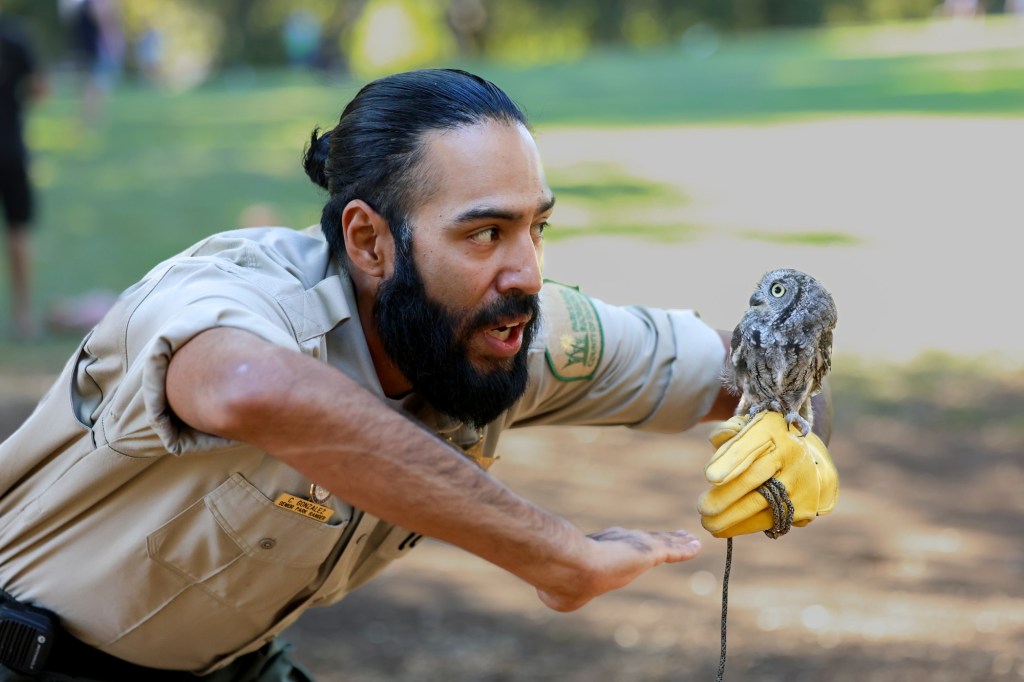Under the shade of oak trees in the late afternoon, about 200 people were fixated on Buster, a red-tailed hawk.
As handler Christian Gonzalez slowly walked through the crowd with Buster on his gloved hand, he explained that raptors are birds of prey that make their living by catching and eating other animals to survive.
“They are air-to-ground combat specialists, and love to eat the 3 R’s — rodents, rabbits and reptiles,” said Gonzalez, a senior park ranger for San Diego County Parks and Recreation.
These “apex predators of the sky” have three main adaptations that allow them to be such efficient hunters — their beaks, talons and eyes, he said.
Gonzalez and Buster were park of the Hawktober event, held at Dos Picos County Park in Ramona on Oct. 18.
Senior Park Ranger Christian Gonzalez of El Monte Park in Lakeside educated the audience about the behavior and characteristics of large predatory raptors. (Stephanie Ogilvie)
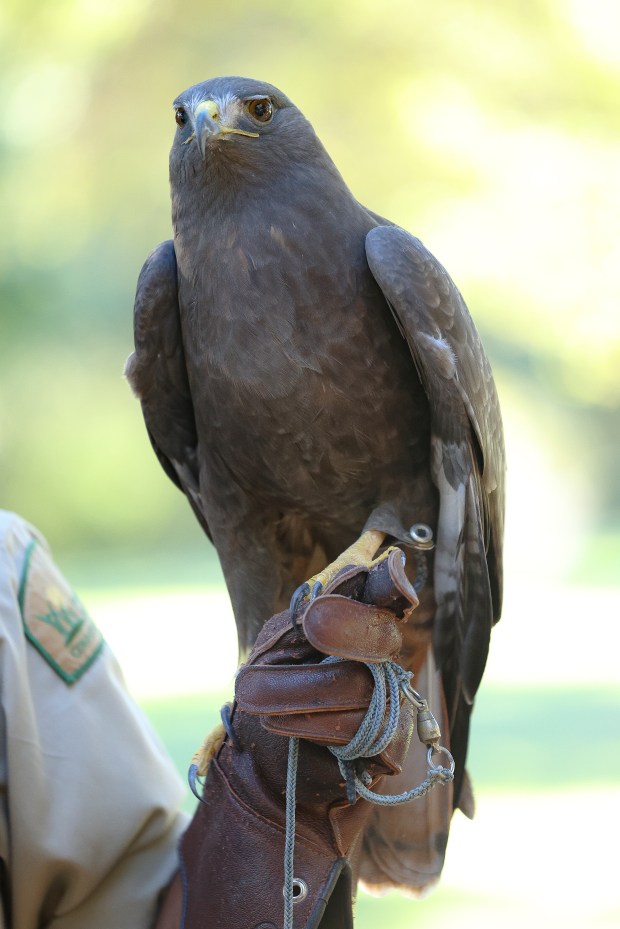
Buster, a red-tailed hawk, is part of the San Diego County Parks Raptor Ambassador program. Buster was part of the ‘Hawktober’ program at Dos Picos County Park on Oct. 18. (Stephanie Ogilvie)
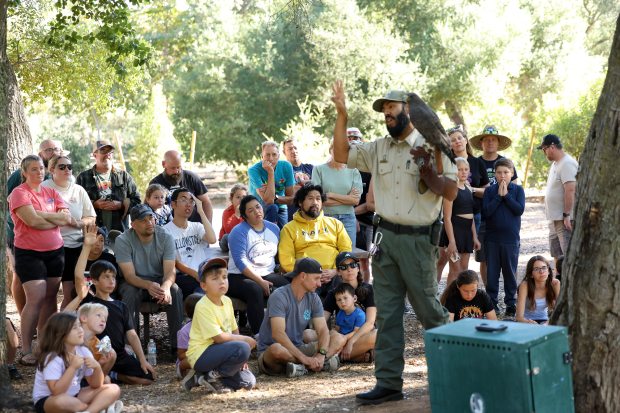
About 200 people from around San Diego attended the Hawktober event at Dos Picos County Park on Oct. 18. Senior Park Ranger Christian Gonzalez educated the crowd about the important role raptors play in the environment. (Stephanie Ogilvie)
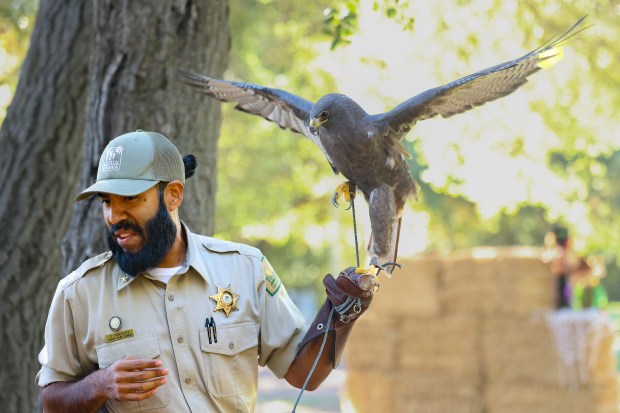
Buster shows off his impressive wingspan during the hawk presentation at Dos Picos County Park, hosted by San Diego County Parks. Male red-tailed hawks typically have a wingspan ranging from about 3.5 to 4.5 feet. (Stephanie Ogilvie)
Show Caption
1 of 4
Senior Park Ranger Christian Gonzalez of El Monte Park in Lakeside educated the audience about the behavior and characteristics of large predatory raptors. (Stephanie Ogilvie)
Hawktober at the county parks began seven years ago, when Gonzalez joined a fellow ranger to host an event focused on raptors and owls. They chose October because so many raptors migrate during the month.
Buster is a somewhat rare melanistic, or dark morph, of the red-tailed hawk; he has a dark belly and dark red tail instead of the usual brown and white coloring, with a streaked belly and red tail.
While human eyes can see the shimmers of heat when temperatures rise to the high 90s or 100s, raptors can see the same heat shimmers in the low 60s, Gonzalez told the crowd.
“As heat rises, raptors are able to see a vortex of heat and ‘ride’ or allow it to carry them to the top,” he said. “They then drop down and ride the next vortex back up. They are masters at soaring and gliding.”
Raptors can see eight times better than humans, Gonzalez said.
“They can see a field mouse run across a football field from above, and their eyes allow them to see two things at once, such as a detailed magnified view and motion detection,” he said. “If they were human, they could text and drive at the same time.”
Their talons, or claws, can apply 200 to 300 pounds of pressure per square inch, allowing them to rapidly catch, hold and kill their prey. Their hook-shaped beaks allow them to “grip and rip” through flesh, meat and bone, he said.
Red-tailed hawks will also hunt rattlesnakes.
“After finding a snake, they form a ‘matador’ stance,” Gonzalez said, demonstrating how the birds place their wings in front of their bodies to cover the reptile. “Since there are no veins in the birds’ legs, they will then ‘tease’ the snake until it strikes; once it does, the bird immediately grabs it behind the head and kills it.”
Buster has been in the care of the county Parks Department for the past 15 years, and Gonzalez said he has developed a strong bond with the bird after being his handler for the past 10 years.
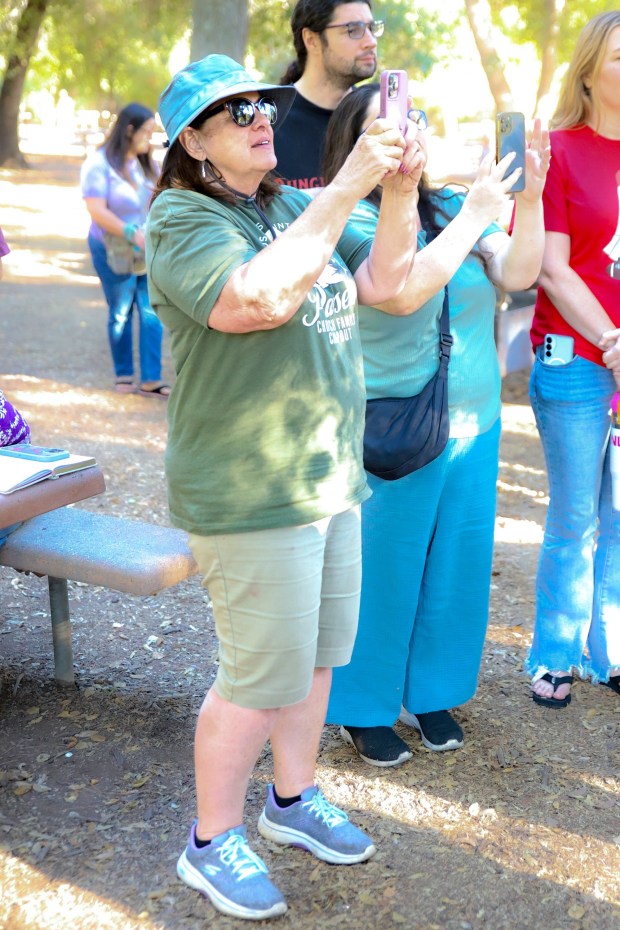 At the end of the Hawktober presentation, Senior Park Ranger Christian Gonzalez opened the floor to questions from the guests. Sue Woods, an avid bird and raptor enthusiast from Chula Vista, attended the event with her church group. (Stephanie Ogilvie)
At the end of the Hawktober presentation, Senior Park Ranger Christian Gonzalez opened the floor to questions from the guests. Sue Woods, an avid bird and raptor enthusiast from Chula Vista, attended the event with her church group. (Stephanie Ogilvie)
Among the guests listening to his presentation were Paul and Sue Woods. The couple heard about the event during their weekend stay at Dos Picos, along with more than 150 fellow members of the Paseo del Rey Church in Chula Vista.
When they learned about Hawktober, they decided to stay, eager for the chance to see some of the raptors up close.
“We’re huge bird lovers; we love all the birds,” said Sue Woods, recalling past outings and the birds they had seen.
For Gonzalez’ second demonstration, he brought out Athena, a 3-year-old burrowing owl they received through a rehabilitation program. The tiny owl weighs about 160 grams, or .35 pounds.
Although owls have the same three hunting adaptations as hawks —beaks, talons and sharp eyesight — they use them differently.
“Owls are nocturnal, and their huge eyes take up 60% of their skull, versus 5% in a human,” he said. “They see in black and grayscale instead of in color, which helps them at night. And since their eyes lack movement, they have to turn their heads to see.”
Although most mammals have seven cervical vertebrae in their necks, owls have 13, allowing them to rotate their heads 270 degrees horizontally, as well as vertically.
After making a kill, owls consume the prey whole and return to either their nesting site or a tree, where their feathers make perfect camouflage.
Burrowing owls, like other raptors, have 13 vertebrae in their necks, which allow them to rotate their heads up to 260 degrees. They have a lifespan of three to five years and grow to about 7 to 10 inches tall, with a wingspan of roughly 20 to 24 inches. (Stephanie Ogilvie)
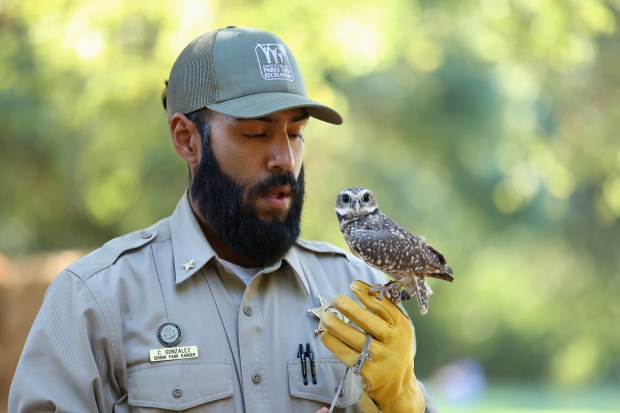
The second raptor featured in the Hawktober presentation was a small burrowing owl named Athena. Burrowing owls can be found in the Ramona Grasslands, with larger populations living near the Salton Sea and Borrego Springs. (Stephanie Ogilvie)
Show Caption
1 of 2
Burrowing owls, like other raptors, have 13 vertebrae in their necks, which allow them to rotate their heads up to 260 degrees. They have a lifespan of three to five years and grow to about 7 to 10 inches tall, with a wingspan of roughly 20 to 24 inches. (Stephanie Ogilvie)
Burrowing owls are unusual in that they nest in burrows in the ground they dig themselves. Being at ground level in their grassland habitats often places them in the path of huge, hungry cattle looking to graze.
To keep the cattle and other animals away, the owls will huddle together, clacking their beaks to mimic rattlesnakes, which cattle instinctively know to avoid.
Burrowing owls typically have a 5-year lifespan. There are only small pockets of the birds remaining at the Ramona Grasslands, the Salton Sea and Borrego Springs.
“We are one disaster away from losing the entire burrowing owl population,” Gonzalez said, emphasizing the importance of habitat conservation for wildlife.
The third raptor in the Hawktober presentation was a screech owl. Screech owls are small, nocturnal birds of prey known for their distinctive “screech” calls. Their feathers provide excellent camouflage, allowing them to blend into tree bark and remain hidden from both predators and prey. (Stephanie Ogilvie)
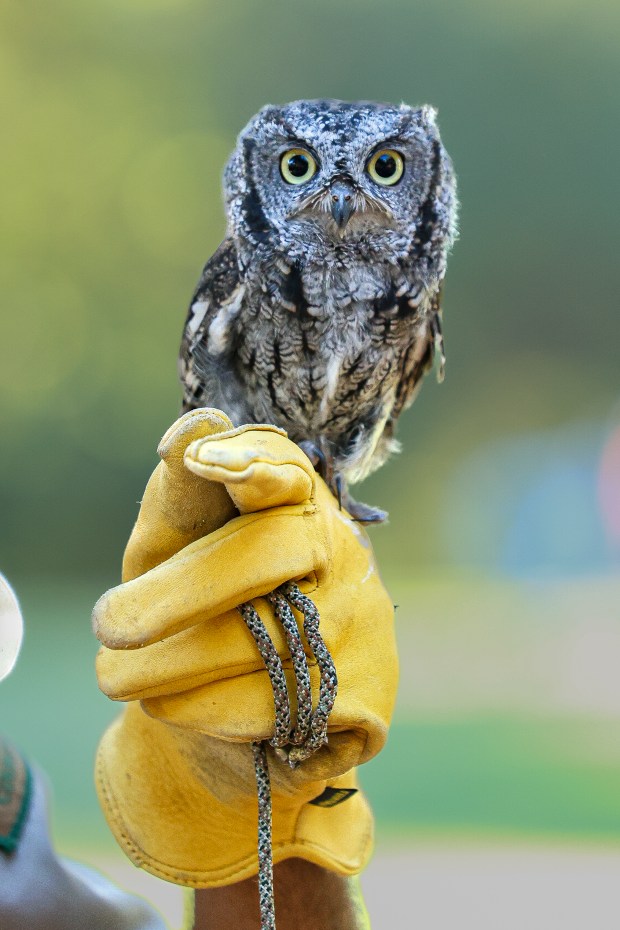
Screech owls are small, typically around 7 to 10 inches tall, making them one of the smaller owl species. They have a lifespan of three to six years and tend to nest in tree cavities or old woodpecker holes. Nocturnal by nature, they are excellent hunters, using their silent flight to sneak up on prey. (Stephanie Ogilvie)
Show Caption
1 of 2
The third raptor in the Hawktober presentation was a screech owl. Screech owls are small, nocturnal birds of prey known for their distinctive “screech” calls. Their feathers provide excellent camouflage, allowing them to blend into tree bark and remain hidden from both predators and prey. (Stephanie Ogilvie)
The final bird Gonzalez presented was a western screech owl. The owl was so new to the program that it didn’t yet have a name for what was its second public appearance.
“Great horned owls hoot, barn owls scream like banshees and screech owls make a noise like a bouncing ball,” he said.
He placed his hand with the owl on it against a tree to show how the small bird matched the bark and effectively “vanished.”
“By mantling, or using her wings like an umbrella to cover her prey, she is able to look like the sky above her to a prey animal and looks like the ground to predators looking at her from above,” said Gonzalez, who has been a ranger for about 10 years and works at El Monte County Park in Lakeside.
He said he became a falconer — legally allowed to keep raptors — after a fellow ranger who was a falconer took him under his wing his first year on the job.
“My favorite part is interacting with the people,” Gonzalez said. “I also love watching the people watch the birds, and how their faces light up as they learn something new about them.”
Originally Published: October 21, 2025 at 3:17 PM PDT

